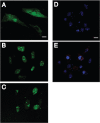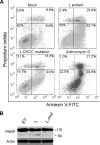Theiler's murine encephalomyelitis virus leader protein is the only nonstructural protein tested that induces apoptosis when transfected into mammalian cells
- PMID: 19403676
- PMCID: PMC2698581
- DOI: 10.1128/JVI.00353-09
Theiler's murine encephalomyelitis virus leader protein is the only nonstructural protein tested that induces apoptosis when transfected into mammalian cells
Abstract
Theiler's murine encephalomyelitis virus (TMEV) induces two distinct cell death programs, necrosis and apoptosis. The apoptotic pathway is of particular interest because TMEV persists in the central nervous system of mice, largely in infiltrating macrophages, which undergo apoptosis. Infection of murine macrophages in culture induces apoptosis that is Bax dependent through the intrinsic or mitochondrial pathway, restricting infectious-virus yields and raising the possibility that apoptosis represents a mechanism to attenuate TMEV yet promote macrophage-to-macrophage spread during persistent infection. To help define the cellular stressors and upstream signaling events leading to apoptosis during TMEV infection, we screened baby hamster kidney (BHK-21) cells transfected to express individual nonstructural genes (except 3B) of the low-neurovirulence BeAn virus strain for cell death. Only expression of the leader protein led to apoptosis, as assessed by fluorescence-activated cell sorting analysis of propidium iodide- and annexin V-stained transfected cells, immunoblot analysis of poly(ADP-ribose) polymerase and caspase cleavages, electron microscopy, and inhibition of apoptosis by the pancaspase inhibitor qVD-OPh. After transfection, Bak and not Bax expression increased, suggesting that the apical pathway leading to activation of these Bcl-2 multi-BH-domain proapoptotic proteins differs in BeAn virus infection versus L transfection. Mutation to remove the CHCC Zn finger motif from L, a motif required by L to mediate inhibition of nucleocytoplasmic trafficking, significantly reduced L-protein-induced apoptosis in both BHK-21 and M1-D macrophages.
Figures








Similar articles
-
Mutation of the Theiler's virus leader protein zinc-finger domain impairs apoptotic activity in murine macrophages.Virus Res. 2013 Nov 6;177(2):222-5. doi: 10.1016/j.virusres.2013.09.001. Epub 2013 Sep 10. Virus Res. 2013. PMID: 24036175 Free PMC article.
-
Theiler's virus-induced intrinsic apoptosis in M1-D macrophages is Bax mediated and restricts virus infectivity: a mechanism for persistence of a cytolytic virus.J Virol. 2008 May;82(9):4502-10. doi: 10.1128/JVI.02349-07. Epub 2008 Feb 20. J Virol. 2008. PMID: 18287228 Free PMC article.
-
Differentiation of M1 myeloid precursor cells into macrophages results in binding and infection by Theiler's murine encephalomyelitis virus and apoptosis.J Virol. 1999 Apr;73(4):3227-35. doi: 10.1128/JVI.73.4.3227-3235.1999. J Virol. 1999. PMID: 10074176 Free PMC article.
-
Theiler's virus persistence in the central nervous system of mice is associated with continuous viral replication and a difference in outcome of infection of infiltrating macrophages versus oligodendrocytes.Virus Res. 2005 Aug;111(2):214-23. doi: 10.1016/j.virusres.2005.04.010. Virus Res. 2005. PMID: 15893838 Review.
-
Differential usage of carbohydrate co-receptors influences cellular tropism of Theiler's murine encephalomyelitis virus infection of the central nervous system.Glycoconj J. 2006 Feb;23(1-2):39-49. doi: 10.1007/s10719-006-5436-x. Glycoconj J. 2006. PMID: 16575521 Review.
Cited by
-
Cultivation and serological characterization of a human Theiler's-like cardiovirus associated with diarrheal disease.J Virol. 2010 May;84(9):4407-14. doi: 10.1128/JVI.02536-09. Epub 2010 Feb 17. J Virol. 2010. PMID: 20164225 Free PMC article.
-
The L-coding region of the DA strain of Theiler's murine encephalomyelitis virus causes dysfunction and death of myelin-synthesizing cells.J Virol. 2011 Sep;85(18):9377-84. doi: 10.1128/JVI.00178-11. Epub 2011 Jul 13. J Virol. 2011. PMID: 21752920 Free PMC article.
-
Apoptotic and antiapoptotic activity of L protein of Theiler's murine encephalomyelitis virus.J Virol. 2011 Jul;85(14):7177-85. doi: 10.1128/JVI.00009-11. Epub 2011 May 11. J Virol. 2011. PMID: 21561911 Free PMC article.
-
Suppression of injuries caused by a lytic RNA virus (mengovirus) and their uncoupling from viral reproduction by mutual cell/virus disarmament.J Virol. 2012 May;86(10):5574-83. doi: 10.1128/JVI.07214-11. Epub 2012 Mar 21. J Virol. 2012. PMID: 22438537 Free PMC article.
-
Viral security proteins: counteracting host defences.Nat Rev Microbiol. 2010 Dec;8(12):867-78. doi: 10.1038/nrmicro2452. Epub 2010 Nov 9. Nat Rev Microbiol. 2010. PMID: 21060318 Free PMC article. Review.
References
-
- Aminev, A. G., S. P. Amineva, and A. C. Palmenberg. 2003. Encephalomyocarditis virus (EMCV) proteins 2A and 2BCD localize to nuclei and inhibit cellular mRNA transcription but not rRNA transcription. Virus Res. 9559-73. - PubMed
-
- Amineva, S. P., A. G. Aminev, A. C. Palmenberg, and J. E. Gern. 2004. Rhinovirus 3C protease precursors 3CD and 3CD' localize to the nuclei of infected cells. J. Gen. Virol. 852969-2979. - PubMed
-
- Barco, A., E. Feduchi, and L. Carrasco. 2000. Poliovirus protease 3Cpro kills cells by apoptosis. Virology 266352-360. - PubMed
Publication types
MeSH terms
Substances
Grants and funding
LinkOut - more resources
Full Text Sources
Other Literature Sources
Molecular Biology Databases
Research Materials

